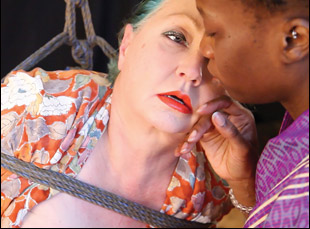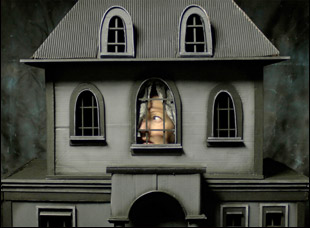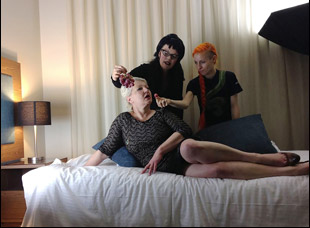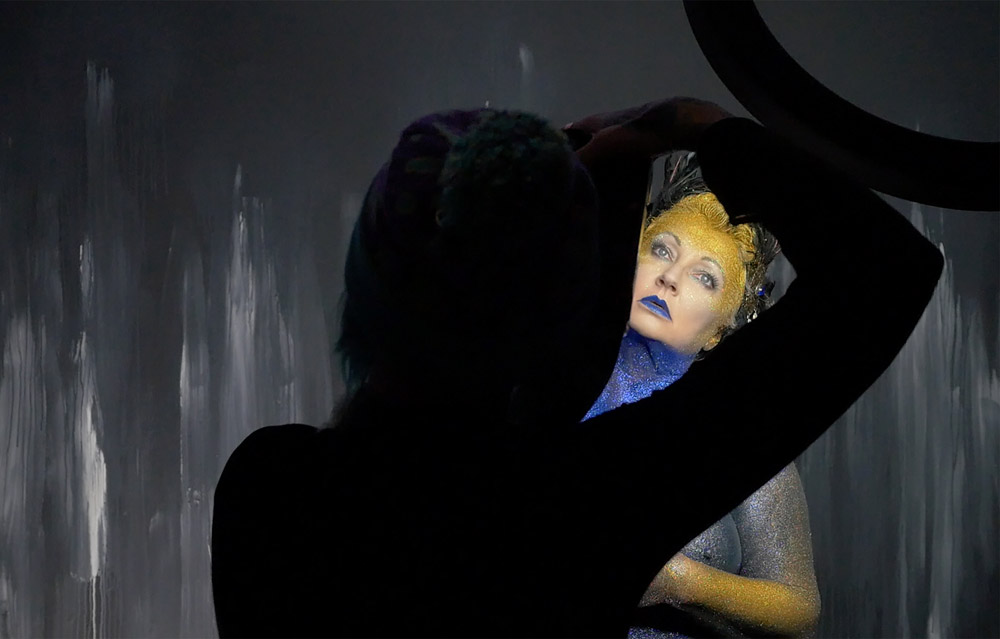Like much of what follows in “Morgana,” there’s a wonderful duality in seeing Morgana Muses digging her own grave in its opening moments. As you come to learn in Josie Hess and Isabel Peppard’s engaging profile, there isn’t all that much reason to be concerned about the light amount of dirt being piled upon Muses as she’s curled up in a hole, directing herself in a scene for her latest film where the morbid imagery is actually a sign of new life upon being liberated from an unhappy marriage, not only being able to express fantasies she couldn’t act upon during her 12-year union, but making a living doing so as a porn performer and director.
While it’s no doubt a compelling hook that Muses is older than the competition for best first-time director when she begins taking her films out on the festival circuit, Hess and Peppard discover within the tale of the onetime housewife from Albury, Australia a fascinating journey of self-discovery as Muses is empowered by making films that can so often be seen as a source of exploitation and offers ways to reflect desires that she has long had to suppress. The fact that it emerges from an equally dynamic perspective from off-screen also surely helps, as Hess, a longtime editor and cinematographer for Muses, and Peppard, a stop-motion animator whose mother had long been a lecturer covering issues of human sexuality, drugs and human behavior, team up to inventively bring Muses’ complicated emotions to the surface, revealing what she’s unconscious of in her own work as she continues to see herself as the person she once was rather than who she projects onto the screen.
With “Morgana” making its North American debut as part of Fantasia Fest following its premiere in its home country at the Melbourne Film Festival last year, Hess and Peppard spoke about how they collaborated on this spirited biography and the need to push on every time they thought the ever-evolving story felt as if it had come to a conclusion, as well as making a film about a filmmaker and using animation to recreate parts of Muses’ life that there were little remnants of.
Isabel Peppard: Josie and I already knew each other through the horror world and she’d been working with Morgana for a while on her films. Morgana had this extravagant experience set up for her 50th birthday, and they wanted to bring in another director to direct that experience, so they approached me. I’d only done stop-motion animation before, so it was a bit random, but Josie told me only a few years ago [Morgana] was a housewife in rural Australia and I was like, “Who is this person?” For me, I was less interested in directing that and more interested in Morgana’s story, so then Josie and had a huge conversation like, “Yeah, this is actually a really great story. Why don’t we make this into a documentary on its own rather than just the 50th birthday experience?”
Josie Hess: I knew about the housewife to pornstar situation, but I didn’t realize just how she got there, so it wasn’t until Is and I came together and we’re like, “We need to start making documentaries because we have a very similar aesthetic and tastes.” I had started working with Morgana out of film school because I’d been trying to make a documentary about porn, which I didn’t really realize was illegal in Australia, and that led me to this path of being an intern on mainstream porn sets and just discovering this whole underground scene in Australia and that led me to working with Morgs.
Did it help having different perspectives with one working closely with Morgana and one at a remove?
Josie Hess: So much. We intentionally kept that separation, so having one person that knows Morgana, we need someone who is more objective.
Isabel Peppard: Josie was really enmeshed in their relationship – more so as the film went on and also with Morgana’s filmmaking practices, they make films together and from my perspective, I wanted to get to know Morgana as the audience got to know her. Although I was getting a lot of feedback from Josie, I knew very little about [Morgana] except for this surface thing, which allowed me to be both surprised by her constantly and to have these expectations that we had of her being constantly overturned during the process of the filmmaking, which is what kept us interested to some degree.

Josie Hess: It’s something we talked about a lot because obviously Morgana’s a filmmaker and any kind of documentary where the subject is also a director herself, we had to work hard to keep that separate. Morgana was never in the edit, and there was a very conscious effort to just observe and follow and not direct her in order to do stuff that would serve our purposes. Honestly, we didn’t have to. The things she came up with, you wouldn’t dream of someone choosing such perfect metaphors and visual [ideas]. It was definitely Morgana, she would do those sorts of things.
Isabel Peppard: Yeah, it was very, very limited apart from the fact that she would do these creative things that were pushing the narrative in different directions that would inspire us to do our creative things. Ethically, we wanted to show her the cut before we picture-locked because we didn’t want to have it be a horrible surprise to her, but the only feedback came just before fine cut when Josie had to watch it with her in a room, which had been really intense. But she was very happy with how we portrayed her and she had a few small privacy changes about other people that had been in photos. That was our only feedback that she gave us.
The animation throughout is such a beautiful part of the film. How did those ideas develop?
Isabel Peppard: Some people don’t realize all the desert stuff is animation, which I think means we did a good job. All the stuff about her childhood, all the tunnels — those are all sets and they’re done with motion control. When we started making the project, the first thing we shot was Morgana’s Phoenix installation, so that was the first creative spark [for this] fantasy backbone of miniatures that illustrated her personal mythology and her internal world. From the Phoenix installation, we retrofitted this idea of this cardboard suburb facade that burnt down and then she’s in the ashes of her identity and then she’s lifted from the ashes and identity void up into the phoenix, and then that ends up being the second facade [where it’s] this version of her [being] the perfect feminist pornstar and everything’s fine and she hasn’t dealt with any of her other issues. She’s still living up to the expectations of other people and then in the second half of the film, she cycles through another cycle of death and rebirth, literally [being] buried alive and emerge out of that as this complete version of herself [as you see in the beginning of the film].

We [knew we had] this big rope installation, so [we wondered] what’s the in-between imagery that we need [and it became] the appearance of desire — this red thread appearing in the ashes and grabbing onto them — and then the cardboard house facade needed to be fleshed out more, so we shot that whole big suburb in a separate shoot in my garage, and that suburb was actually constructed from things from her wedding album. I scanned the textures of the cover of the wedding album and some of the pattern work and used that to construct the paper suburbs, so it was a process as the story developed, always tied to her psychological experience and not just, “Here’s a big house. See you later!” in the middle of the film.
Josie Hess: And as Morgana kept creating her films, it became more collage because we found a way to visually meet the world that she had also created, which was big and metaphorical. It was a really interesting experience [where] it was like a call and response between Morgana’s creations, Is’s creations and my creations and just finding a way to weave them all together. The way we created was very much in dialogue – there’s a lot of discussion about how to pull all these disparate elements together.
What made you pull the trigger on turning this into a feature when it was conceived as a short?
Josie Hess: She just made some really big life choices. It was about 2015 and we were like, “Done and dusted our short, we got what we need” and it’s like, “Actually, I’m making this huge life decision” and we were like, “Let’s just keep filming and see where this goes.”
Isabel Peppard: Yeah, we did a lot of different cuts. In 2015, I did the first full cut, and I had never cut a short or a feature doco, so I didn’t know what the fuck I was doing, and in that cut, it ended with that [first big life change] and then Josie did cuts as well…
Josie Hess: We all had a crack at recutting this film. [laughs]
Isabel Peppard: It ended in quite a few different places and then finally when I did that cut, it was almost a feature already and then it kept going. [laughs]
Josie Hess: For years. But the journey of a documentary is that filling out our understanding of this woman and getting to the heart of somebody, which I think over a long friendship, we often do. Without going into spoilers, I think we end up in a much more honest place than perhaps the type of person that you’d want to be your feminist idol/hero/pornstar. You can be that, but you can also be so much more – that’s what unfurled for us along the way.

Isabel Peppard: It’s awesome. It’s such a great experience, having it connect with people and we premiered at the Melbourne International Film Festival last year before the coronavirus, and Morgana got a standing ovation, so she was very happy, so just be able to connect with people. We’ve had so much different feedback from people that have been touched in different ways by the story, so that’s gratifying.
Josie Hess: It feels like one of those films where you feel so proud, and I’m sure Is, you feel the same way, that this is our first feature, like to put our names on this specific story with that particular ending shot [right] into people’s faces.
Isabel Peppard: Yeah, we got to see that end shot in a cinema and it was at the Capital Theater in Melbourne, a very grand, crazy art deco theater, a 600-seater cinema, so we got to see like, “Smash.”
Josie Hess: So it’s unbelievable, really. It’s unbelievable it’s happening at all.
“Morgana” will be streaming on demand at Fantasia Fest, running through September 2nd.





